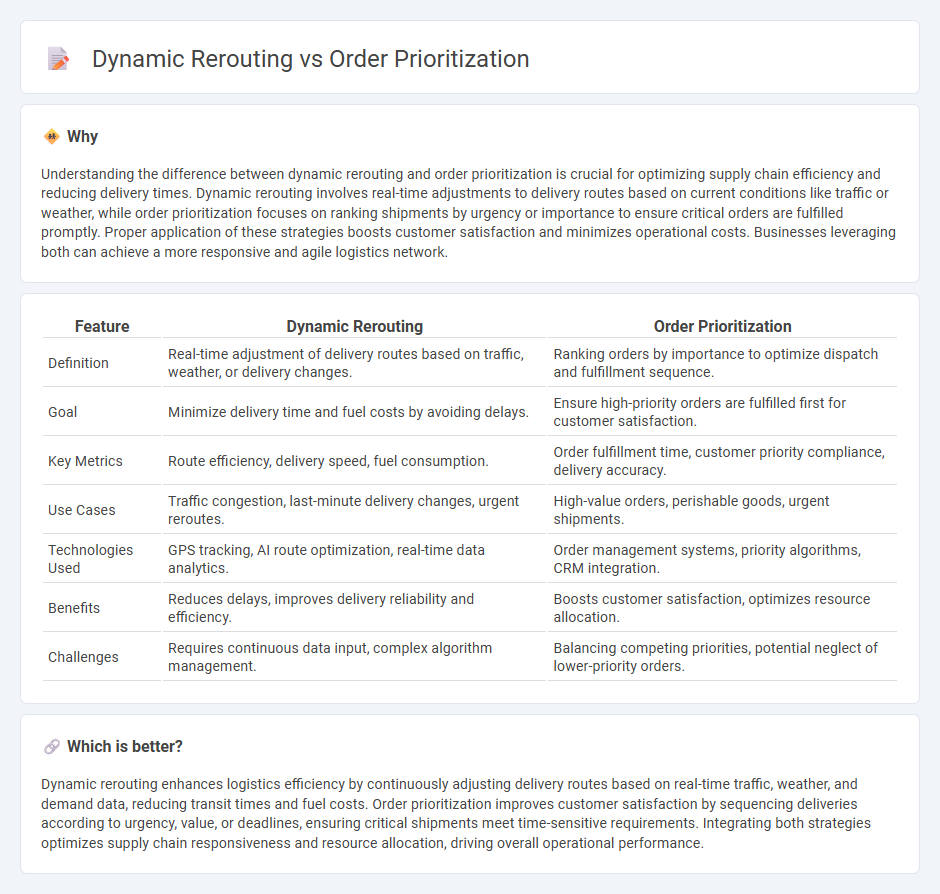
Dynamic rerouting optimizes delivery routes in real-time by analyzing traffic patterns, weather conditions, and vehicle availability to minimize delays and reduce fuel costs. Order prioritization assigns shipment urgency based on customer requirements and inventory levels, ensuring critical deliveries are fulfilled promptly to maintain service quality. Explore more to understand how integrating these strategies enhances supply chain efficiency and customer satisfaction.
Why it is important
Understanding the difference between dynamic rerouting and order prioritization is crucial for optimizing supply chain efficiency and reducing delivery times. Dynamic rerouting involves real-time adjustments to delivery routes based on current conditions like traffic or weather, while order prioritization focuses on ranking shipments by urgency or importance to ensure critical orders are fulfilled promptly. Proper application of these strategies boosts customer satisfaction and minimizes operational costs. Businesses leveraging both can achieve a more responsive and agile logistics network.
Comparison Table
| Feature | Dynamic Rerouting | Order Prioritization |
|---|---|---|
| Definition | Real-time adjustment of delivery routes based on traffic, weather, or delivery changes. | Ranking orders by importance to optimize dispatch and fulfillment sequence. |
| Goal | Minimize delivery time and fuel costs by avoiding delays. | Ensure high-priority orders are fulfilled first for customer satisfaction. |
| Key Metrics | Route efficiency, delivery speed, fuel consumption. | Order fulfillment time, customer priority compliance, delivery accuracy. |
| Use Cases | Traffic congestion, last-minute delivery changes, urgent reroutes. | High-value orders, perishable goods, urgent shipments. |
| Technologies Used | GPS tracking, AI route optimization, real-time data analytics. | Order management systems, priority algorithms, CRM integration. |
| Benefits | Reduces delays, improves delivery reliability and efficiency. | Boosts customer satisfaction, optimizes resource allocation. |
| Challenges | Requires continuous data input, complex algorithm management. | Balancing competing priorities, potential neglect of lower-priority orders. |
Which is better?
Dynamic rerouting enhances logistics efficiency by continuously adjusting delivery routes based on real-time traffic, weather, and demand data, reducing transit times and fuel costs. Order prioritization improves customer satisfaction by sequencing deliveries according to urgency, value, or deadlines, ensuring critical shipments meet time-sensitive requirements. Integrating both strategies optimizes supply chain responsiveness and resource allocation, driving overall operational performance.
Connection
Dynamic rerouting enhances logistics efficiency by continuously adjusting delivery paths based on real-time traffic, weather conditions, and order urgency, ensuring faster fulfillment. Order prioritization categorizes shipments by importance, enabling automated systems to allocate resources and optimize routes accordingly. Together, these strategies reduce transit times, lower costs, and improve customer satisfaction in supply chain management.
Key Terms
**Order Prioritization:**
Order prioritization enhances supply chain efficiency by systematically ranking orders based on factors such as delivery deadlines, customer importance, and product availability. This method reduces lead times and improves customer satisfaction by ensuring critical orders are fulfilled promptly. Explore how advanced order prioritization strategies can optimize your logistics operations and boost service quality.
Service Level Agreements (SLA)
Order prioritization enhances Service Level Agreements (SLA) compliance by assigning urgency to high-value or time-sensitive shipments, ensuring timely deliveries aligned with customer expectations. Dynamic rerouting improves SLA adherence by adjusting delivery paths in real-time to avoid delays caused by traffic, weather, or logistical disruptions. Explore detailed strategies to optimize SLA performance through order prioritization and dynamic rerouting techniques.
Demand Forecasting
Order prioritization leverages demand forecasting to allocate resources efficiently by analyzing predicted customer demand patterns. Dynamic rerouting adapts logistical routes in real time to meet fluctuating demand forecasts, minimizing delivery delays and optimizing supply chain responsiveness. Explore how integrating advanced demand forecasting enhances both order prioritization and dynamic rerouting strategies to boost operational efficiency.
Source and External Links
Guide to Order Prioritization - WareSpace - Order prioritization means fulfilling orders in a sequence aligned with business goals and customer expectations, using methods like FIFO, Earliest Due Date, and FEFO to manage surges and time-sensitive shipments effectively.
What Is Order Prioritization? | Fulfyld - Order prioritization determines which orders to fulfill first based on urgency, customer status, inventory, or order volume, improving efficiency and customer satisfaction especially during high demand or limited stock situations.
Understanding Order Prioritization and Its Importance - StockIQ - It is a systematic approach prioritizing orders by urgency, value, customer type, inventory, shipping distance, or processing time, with common strategies including FIFO, Earliest Due Date, and customer priority to optimize delivery operations.
 dowidth.com
dowidth.com